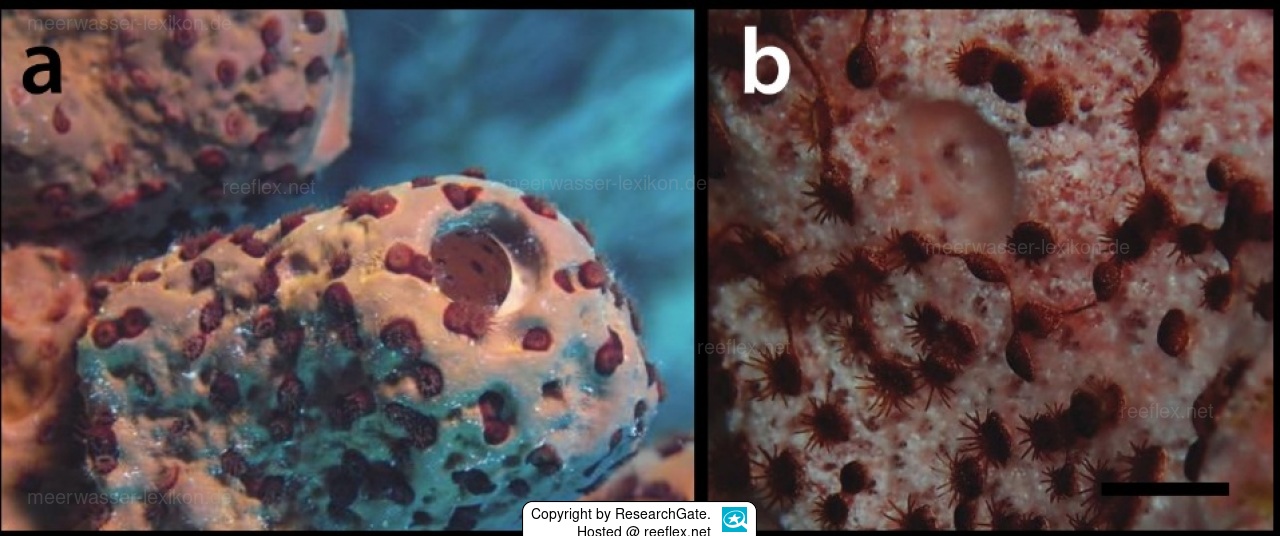Info
Bergia puertoricense, a crustose anemone, forms colonies with polyps regularly distributed over the surface of their host sponges, but also clusters consisting of two or more polyps, but the distribution of polyps varies depending on the host sponge.
Polyps are 1 mm high and 1.5 mm in diameter in living specimens, fully retracted polyps are sac-shaped and protrude only slightly above the surface of the coenenchyma surrounding the polyps is rarely larger than 2 mm.
The tentacles are arranged in two cycles and are up to 1 mm long in living and expanded specimens.
The polyps exhibit abundant pigmentation and a dense concentration of sponge needles and calcareous sand grains, with an overall maroon color.
Since the genus Bergia has only recently been revived, this species usually appears in the literature as Parazoanthus puertoricense.
The crustose anemone Bergia puertoricense has been found associated with the following sponge species:
Petrosia (Petrosia) weinbergi van Soest, 1980, Petrosia (Petrosia) aff. weinbergi, Agelas clathrodes (Schmidt, 1870), Agelas conifera (Schmidt, 1870), ( Agelas cf. conifera (Schmidt, 1870), Svenzea zeai (Alvarez, van Soest & Rützler, 1998), Topsentia sp. and Xestospongia sp. in Curaçao; and with Svenzea zeai (Alvarez, van Soest & Rützler, 1998) in Sint Eustatius.
Synonym: Parazoanthus puertoricense West, 1979
Source:
ReasearchGate
Authoren: Montenegro, Hoeksema, Santos, Kise
Hexcorallia (Cnidaria: Hexacorallia) of the Dutch Caribbean with historical distribution records from the Atlantic and one new species of Parazoanthus
DOI:10.3390/d12050190
This article is an open access article distributed under the terms and conditions of the Creative Commons Attribution (CC BY) license (creativecommons.org).
Polyps are 1 mm high and 1.5 mm in diameter in living specimens, fully retracted polyps are sac-shaped and protrude only slightly above the surface of the coenenchyma surrounding the polyps is rarely larger than 2 mm.
The tentacles are arranged in two cycles and are up to 1 mm long in living and expanded specimens.
The polyps exhibit abundant pigmentation and a dense concentration of sponge needles and calcareous sand grains, with an overall maroon color.
Since the genus Bergia has only recently been revived, this species usually appears in the literature as Parazoanthus puertoricense.
The crustose anemone Bergia puertoricense has been found associated with the following sponge species:
Petrosia (Petrosia) weinbergi van Soest, 1980, Petrosia (Petrosia) aff. weinbergi, Agelas clathrodes (Schmidt, 1870), Agelas conifera (Schmidt, 1870), ( Agelas cf. conifera (Schmidt, 1870), Svenzea zeai (Alvarez, van Soest & Rützler, 1998), Topsentia sp. and Xestospongia sp. in Curaçao; and with Svenzea zeai (Alvarez, van Soest & Rützler, 1998) in Sint Eustatius.
Synonym: Parazoanthus puertoricense West, 1979
Source:
ReasearchGate
Authoren: Montenegro, Hoeksema, Santos, Kise
Hexcorallia (Cnidaria: Hexacorallia) of the Dutch Caribbean with historical distribution records from the Atlantic and one new species of Parazoanthus
DOI:10.3390/d12050190
This article is an open access article distributed under the terms and conditions of the Creative Commons Attribution (CC BY) license (creativecommons.org).







 ResearchGate
ResearchGate




